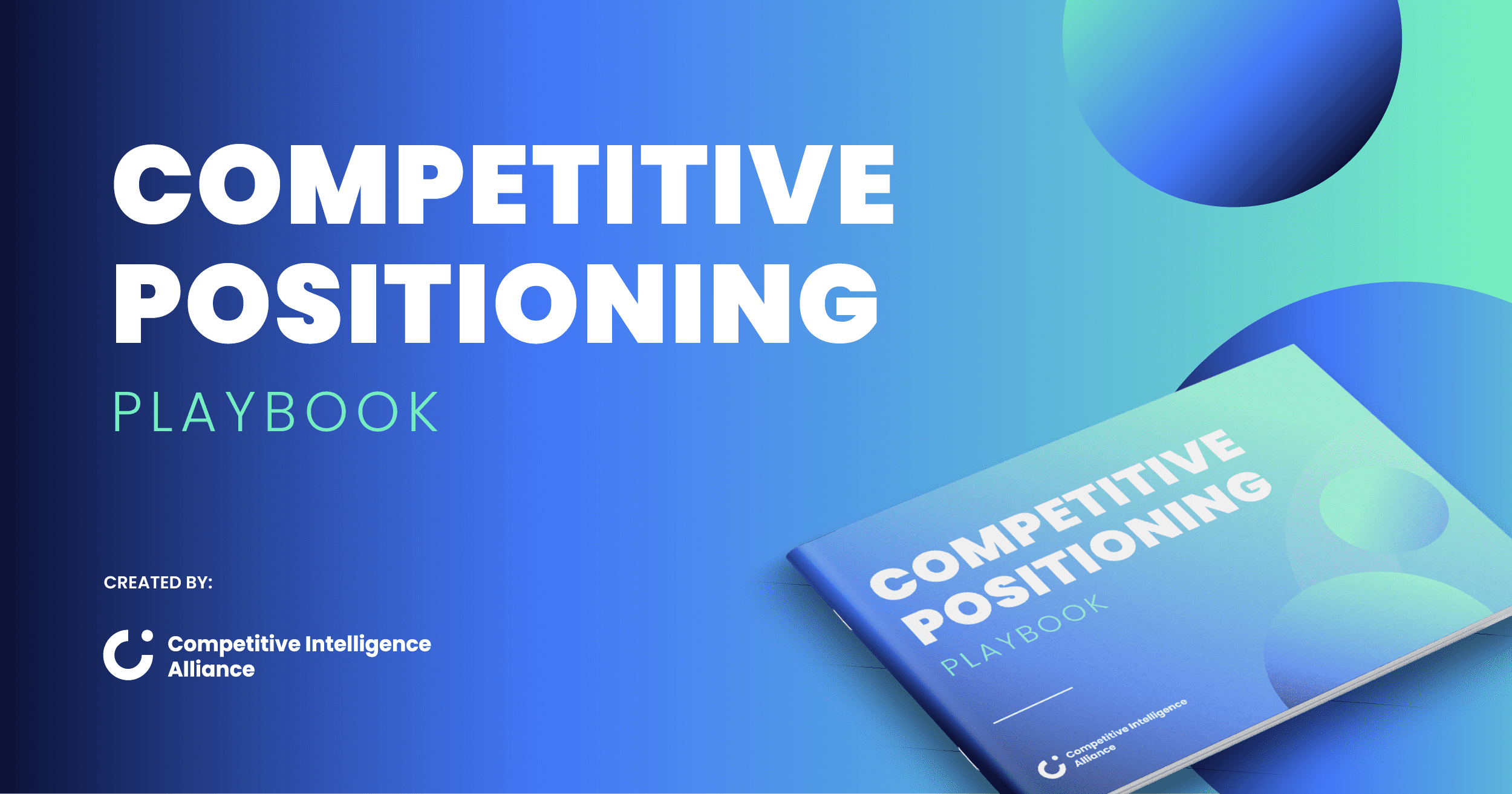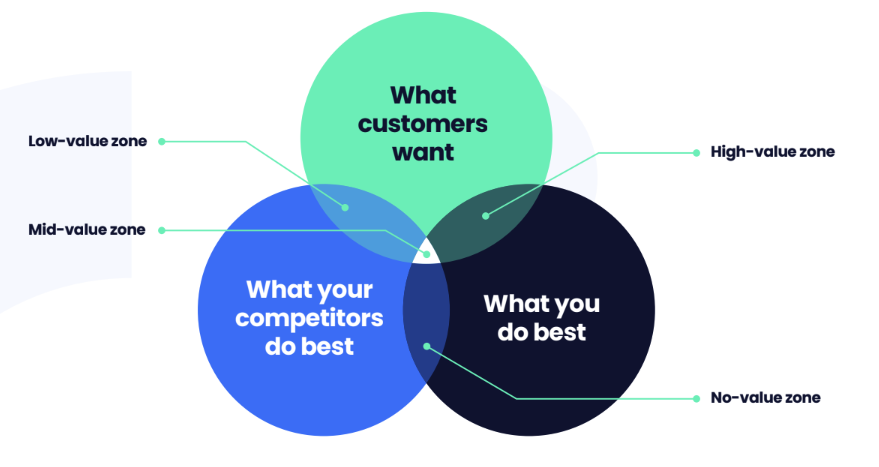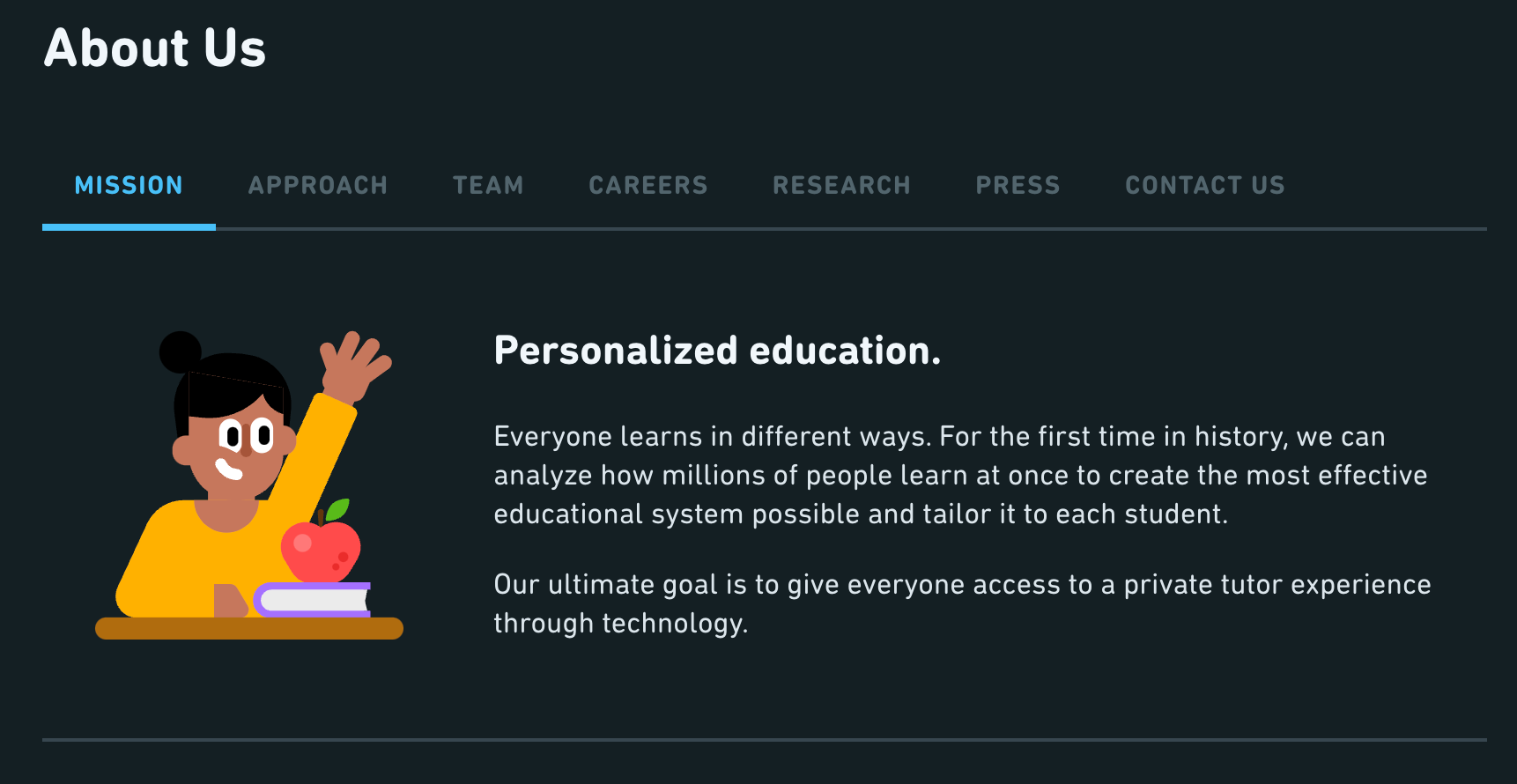What is a positioning statement?
Your brand positioning statement is a single sentence that sums up your competitive position - it’s your elevator pitch. If you were to describe to a new hire (or anyone else in the business) how you want people to see your product, your positioning statement would fill that role.
Your positioning statement is a key deliverable in the competitive positioning process. One that will be invaluable to your colleagues. Though it might feel sacrilegious to whittle your hard work down to one sentence, it’s worth it. It’ll force you to carve every facet of your findings down to the single pillar holding up everything else.
This makes your brand’s position in the market more communicable across teams and to new hires. It makes it more understandable, too, and gets everyone on the same page about where the brand stands. Finally, it lets everyone know how they should speak about the product and the brand to prospects, ensuring a more cohesive buyer journey with a higher conversion rate.

What a positioning statement is not
You shouldn’t confuse your positioning statement with:
- Your business’ mission statement.
- Your product’s value proposition.
Your business’ mission statement outlines why your business has taken a position in the marketplace at all. It relates to what the business wants to achieve, and the values you hold as a collective.
Many businesses today care about sustainability, social justice, or about pushing the frontiers of human achievement. Mission statements encapsulate these things, and tend to be independent of the murkier, scrappier realities of doing business in a competitive space.
A value proposition outlines precisely what makes its product or service valuable to customers. This often involves language about the specific problems and pain points the product or service solves for customers, and why those are the right ones to focus on.
For example, a password manager’s value proposition would refer to the practical issues people face staying secure online while trying to remember unique logins for all their accounts.
3 reasons why you need a brand positioning statement
1) A value proposition isn’t enough
Even if you already have a mission statement and have stated your product’s value proposition, neither of these encapsulates your positioning. And since positioning is a necessary piece of the puzzle, you need to cover that base.
Remember, a positioning statement describes your place in the competitive landscape. It takes competitor solutions into account, while a simple value proposition doesn’t.
Your reasons for being in business, and the unique benefits your product will provide to customers, aren’t enough to convince prospects why they should choose you instead of a superficially similar alternative. Your competitive positioning statement should clarify what problems you’re solving, for whom, and how you manage to be the best option available.
2) Leaving your positioning up to interpretation means leaving money on the table
If different people interpret your positioning differently, they’ll speak about your product differently to prospects.
This is liable to confuse prospects, and muddle up the buyer’s journey.
You want your funnel to be like a greased slide, sucking people in, and whisking them along to the “ready to buy” phase with as little friction as possible.
Imagine you’re researching a product. The website leaves you with one sense of who they are, what they do, and how they relate to alternatives. Speaking to a salesperson on the phone, you’re left with a slightly different impression. A follow-up conversation with someone else leaves you with a third impression. None of these impressions match.
You’d feel confused, right?

Confusion and doubt are anathema to the buying decision. Uncertainty means risk. And part of your job as a competitive intelligence or product marketing professional is to de-risk the buying decision for your prospects.
If you show your buyers that even employees can’t agree on the reasons why their product is the right one for them, you’ll degrade trust, and increase the amount of last-minute resistance you face come crunch time.
3) Positioning goes hand-in-hand with messaging
Remember, if you don’t communicate consistently with prospects about your products, they’ll find it difficult to form a coherent picture of your brand.
Having consistent messaging associated with your products and your brand is therefore critical for making prospects trust your brand.
But before you can have solid, consistent guidelines around your messaging, and define how you’ll communicate with your prospects, you need to know what you’ll communicate to them.
The way to do this is with a positioning statement.
Your positioning statement acts as the single source of truth telling folks across the business where your product wins, and the defensible space you occupy in the competitive landscape. It gets people on the same page about your competitive advantage, and how to communicate it when talking about your product.
How to create a positioning statement
You’re not just positioning, you’re positioning competitively. So when you’re writing a positioning statement, you want to incorporate what you’ve learned about your competitors. The process will look like this:
- Outline your product’s features.
- Turn those features into emotional benefits.
- Identify the emotional benefits that customers care about the most.
- Identify the emotional benefits that you deliver better than any competitor.
- Identify the ways in which you’re the antidote to a competitor’s weaknesses.
- Summarize these into a positioning statement.

No product is created in a vacuum
The Competitive Positioning Playbook teaches you...
👷 How to blend CI and customer research for a rock-solid positioning strategy.
🙅♀️ The three steps you must not skip in crafting competitive positioning.
🪛 A top-to-bottom tear down of the positioning process, and how CI fits in.
🏹 How to use competitive positioning to shatter your org’s revenue ceiling.
Interested? Click the button right now to check it out.
Creating a competitive positioning strategy
Before you can craft a positioning statement, you need to know what space in the market you should occupy.
If you haven’t yet done this work, don’t worry. We’re here to help.
Here’s a tip: Don’t position yourself to fight an unwinnable battle.
Fight where you know you can win. Anything else is a waste of resources, so you need to position deliberately to target the weaknesses in your competitors’ products, while making the most of your own strengths.

As the above diagram shows, you only exist in relation to what your customers want, and what your competitors or alternatives offer to that same audience.
Opportunities abound in these zones:
High-value zone: You offer customers what they want with little to no strong competition.
Mid-value zone: You offer customers what they want with strong competition, but it’s a close race.
i) The high-value zone
There’s often a temptation to assume you’re playing in the high-value zone by default. Especially if others in the organization are dismissive of your competitors. But there’s no excuse for assuming you’re strong, or that your competitors are weak, in any given area. You need to hear it from your customers.
When your research and analysis suggests you can position yourself in the high-value zone, do so. And make the most of it. The high-value zone necessarily shrinks as competitors imitate you.
No competitive edge can stay large for long. At least not without understanding your competitive advantage extremely well and defending it against imitation by cutting off your competitors’ avenues of attack. That means patenting or trademarking your intellectual property, or negotiating exclusive contracts with suppliers, for example.
ii) The mid-value zone
Mid-value zones are like swing states. A few votes in either direction can mean the difference between winning and losing a deal.
These are massively leveraged opportunities to impact revenue, where a few persuasive points in your favor could help you win a large number of deals, or a small number of very high-value deals.
It pays to invest here, but the fight will be constant as you and your competitors race to create the best solution and convince prospects.
iii) The low- and no-value zones
These are the zones where you’re competing with very strong alternatives where your own offering is weak, or you’re competing with a strong competitor for something the market isn’t interested in.
Obviously, you shouldn’t aim to position yourself in either the low-value or no-value zones, but don’t forget about them altogether.
Audit your positioning at intervals to make sure you’re not in danger of drifting into one of these zones as the competitive landscape shifts and new competitors enter the fold.
7 Positioning statement examples
We’ve tracked down 7 examples of official, publicly available statements that encapsulate some of the aspects of positioning we’ve spoken about. Check them out:
1) Semrush
“The best marketers enjoy and love what they do. Semrush ensures marketing professionals always have time for creativity and experiments while we take care of data. Semrush is the only software which enables marketing professionals to build, manage, and measure campaigns across all channels to improve their online visibility. Semrush is your digital team member—your analytics buddy, your mentor, your safety net, and a compass to new markets.”

Positioning statements don’t have to mention competitors by name, and - in fact - almost always shouldn’t. Semrush’s statement above, though, calls attention to the fact that theirs is “the only software” that lets you “build, manage, and measure” across all channels.
Airtable’s Director of Product Marketing, Alex McDonnell, says most businesses can occupy one of three different positioning buckets: the Aggregator, the Simplifier, and the Specializer.
Semrush, here, exhibit the Aggregator archetype. Where businesses used to have to manage their channel campaigns using multiple software products, and measure them in still others, now they can do everything with a single product.
2) DuoLingo
“Personalized education: Everyone learns in different ways. For the first time in history, we can analyze how millions of people learn at once to create the most effective educational system possible and tailor it to each student.
"Our ultimate goal is to give everyone access to a private tutor experience through technology.”

DuoLingo’s positioning statement calls out what it’s able to offer that’s new: its analytics. DuoLingo goes head-to-head with traditional language education and aims to use its data to create a system that democratizes language learning in a way that was impossible up ‘til now.
3) Makita
“Makita has always had the vision that society and global communities should be able to develop for themselves, and future generations. By providing the tools, Makita is ensuring that anything is possible.
"We can be certain of this by the initiatives that guide our business every step of the way. From our regard for the environment, evolving safety measures and innovations in design and manufacturing, we're sure that not only are we contributing to a better today, but investing in a better future.”
Publicly-facing variations of positioning statements can be more verbose than the ideal, snappy, single-sentence versions you should strive to create internally. But Makita’s public statement above implies much about its competitive positioning, while also making clear the business’ mission.
Makita positions itself as a brand that innovates sustainably, while democratizing the power to build and develop through affordable, quality tools.
4) Ryobi:
“Innovation at the service of users: As one of the largest and most innovative power tool manufacturers in the world, we are dedicated to delivering outstanding performance and reliability, we’ve built a solid and enviable reputation by developing a real knowledge of exactly what people need from their power tools, so that you can work more efficiently, more safely and more comfortably in your home and garden.”
Ryobi’s statement, when compared with Makita’s above, is a good example of how two competitors position themselves differently in the marketplace. Makita mentions the environment, sustainability, and the future in relation to its innovation. Ryobi mentions its users in relation to its innovation.
In this sense, Ryobi positions itself as a brand looking to provide its users with tools that solve their specific problems better than any competitor could. Mentioning “home and garden” as the places their tools are likely to be used implies (intentionally or not) that these are tools for use around the home by individuals, and not for industry professionals.
5) Ikea
On its website, Ikea refers to its, “IKEA business idea”:
“To offer a wide range of well-designed, functional home furnishing products at prices so low, that as many people as possible will be able to afford them.”

This is a great, concise positioning statement. Ikea aims to democratize “well-designed, functional” home furniture by offering them at super competitive prices. Their low-cost provider strategy makes for an interesting case study in a business’ pursuit of a competitive advantage.
6) ClickUp:
“Save people time by making the world more productive: While we absolutely love productivity software, we believe productivity, in general, is broken. There's just too many tools to keep track of, too many things in entirely separate ecosystems. There has to be a better way to work - that's why we created ClickUp, first an internal tool, now as a way to fulfill our vision of making the world more productive.”
ClickUp’s positioning statement mentions “too many tools… too many things in entirely separate ecosystems.” Again, this is an example of a brand positioning itself to fill the Aggregator archetype. They’re bringing what were once many siloed solutions together into a single solution, so you can have a single solution for a single big problem.
7) Slack
“Slack is the AI-powered platform for work, bringing all your conversations, apps and customers together in one place. Around the world, Slack is helping businesses of all sizes to grow and send productivity through the roof.”

Slack’s statement, too, echoes the Aggregator archetype, bringing “all your conversations, apps, and customers together in one place.” The references to their global presence, “around the world”, and suitability for “businesses of all sizes” emphasizes the product’s versatility.
How to use your positioning statement for competitive intelligence
Positioning doesn’t stop with a one-pager strategy document. Its influence spreads far and wide to influence many other aspects of the business.
There are a few key deliverables that, once in circulation, provide valuable data about how your positioning is working. This is your enablement content.
Sales enablement collateral, including battlecards, pitch decks, and any other kind of content that eases the sales process for your reps, is perhaps the fastest way of getting to grips with what’s working and what isn’t.
So after your strategy, the enablement assets you create with the positioning you have are perhaps the most important deliverable. Once your reps start using them on calls, you’ll begin to hear how your new positioning is landing. This gives you a sense of what’s working, and what isn’t.
A full process for creating enablement assets is beyond the scope of this article, but here are some ideas:
Battlecards
Battlecards are slides of essential information for your sales reps to call upon when you’re going head-to-head with a key competitor.
They should contain a ‘quick dismiss’ of the competitor, acknowledging their strengths, but quickly explaining why those strengths aren’t so relevant to your target market, or why those strengths don’t put them in the best position to solve the customer’s problem.
That should dovetail nicely into bullet points about why your product is the ‘antidote’ to the competitor’s weaknesses.
Pitch decks
Pitch decks give you a chance to tailor your positioning to a specific target. That might be a potential investor, a new customer, or a client. They visually educate on your product or service, making it very clear how your product can solve their problems and meet their specific needs in ways the competition cannot.
Informational content
Informational articles, product documentation, written guides, product demos, and video walkthroughs… All of these things represent ‘enablement content’, in that your sales reps (and other folks around the business) can save themselves time by sending this content across to prospects to provide valuable information at a particular stage of the buying process.
This standardizes the way your business talks about and explains particular concepts and gives you opportunities to refine that content as you go. You have a decisive ‘control’ piece that gets the job done, against which you can measure the performance of similar content.
Refining and reworking positioning
Your positioning is not a one-and-done thing.
Your positioning statement, and any documents you’ve created, should be living, breathing representations of your positioning that you refresh at intervals. You must continually update in light of new competitor developments, and with the fresh feedback coming in from the systems you put in place at the end of Stage 1.
Over time, you’ll update your positioning statement, strategy, and enablement assets to more accurately reflect where you actually win in the eyes of your customers, and to give you the best possible chance of winning new opportunities.
Here are some tips from the experts on testing, tweaking, and refreshing your positioning:
"Your positioning is always going to be evolving, both at a brand level and in a competitive sense. Keeping track of new releases and new messaging from competitors can help you continue to adjust it. If you see a competitor is adopting a similar story to you, you should A) feel pretty good because mimicking is the sincerest form of flattery! B) Think about updating yours to better position why you're different.”~Mitchell Comstock, Sr. Product Marketing Manager, Medbridge"I’d start by running some experimentation on your top-of-funnel areas to test your positioning. Work with marketing to test landing pages, or paid ads, with your new positioning and see how it’s landing in the market.”~Kevin Chan, Director of Product Marketing, Fleetio"We use CI to evaluate how to launch a new solution and also how to reposition our existing portfolio. The market is constantly evolving, as are the technologies within it – not to mention the actual customer needs, demands, or even regulatory influences...CI helps provide insights as to what others are doing, what we ARE doing, and what we SHOULD be doing next.”~Matt Tyrer, Director of Competitive Intelligence, DruvaSummary
Here’s a quick summary of what we’ve learned:
1 - A good positioning statement distills your brand positioning into an ‘elevator pitch’ one-liner use with your internal teams.
2 - A watertight positioning strategy takes full account of the highest-value market opportunities available to you.
3 - A positioning statement can help you build enablement collateral that helps sales win deals while field-testing all aspects of your new positioning.
4 - It’s important to continue to optimize your positioning and your enablement assets as you move forward and continue to learn more about your customers and competitors.

No product is created in a vacuum
Give me more info!The Competitive Positioning Playbook teaches you...
👷 How to blend CI and customer research for a rock-solid positioning strategy.
🙅♀️ The three steps you must not skip in crafting competitive positioning.
🪛 A top-to-bottom tear down of the positioning process, and how CI fits in.
🏹 How to use competitive positioning to shatter your org’s revenue ceiling.
Interested? Click the button right now to check it out.
Get industry insights
—All you need to know about positioning statements (with 7 examples)







.png?v=09cf73b4b5)